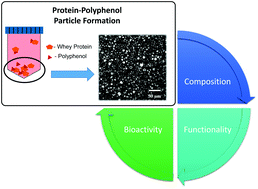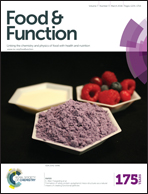Formation of whey protein–polyphenol meso-structures as a natural means of creating functional particles
Abstract
Whey proteins provide structure and nutritional properties in food, while berry juices are thought to have biological activity that can impart anti-inflammatory health effects. In combination, the two could be an excellent source of necessary and supplemental nutrients as well as expand the functionality of whey proteins in food structures. The objectives of this investigation were to (1) develop an approach for particle formation between whey protein and cranberry, blackcurrant, or muscadine grape juices, (2) determine resulting particle composition and physical characteristics, and (3) evaluate properties related to food structure stability and maintenance of phytochemical bioactivity. Particles were formed by combining 20% w/w whey protein with juice containing 50, 250, or 500 μg g−1 total phenolics, adjusting pH to 4.5, and centrifuging to collect aggregated particles. Particles had an approximate molar ratio of 9–50 proteins per polyphenol, and the ratio increased with increasing phenolic content of the juice used to create the particles. Particle size ranged from 1–100 μm at pH 4.5, compared to 10 μm particles that formed when whey protein isolate alone was precipitated at pH 4.5. Polyphenols and other juice components, such as acids and sugars appeared to be involved in particle formation. Particles improved foam stability, and the anti-inflammatory properties of entrapped polyphenols were maintained in the particles. Highly functional protein–polyphenol particles can be designed to stabilize food structures and simultaneously deliver polyphenols associated with health benefits.


 Please wait while we load your content...
Please wait while we load your content...